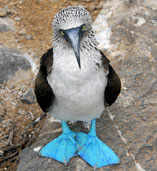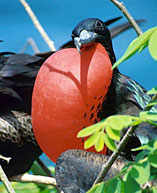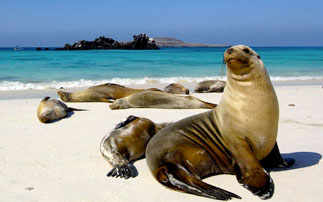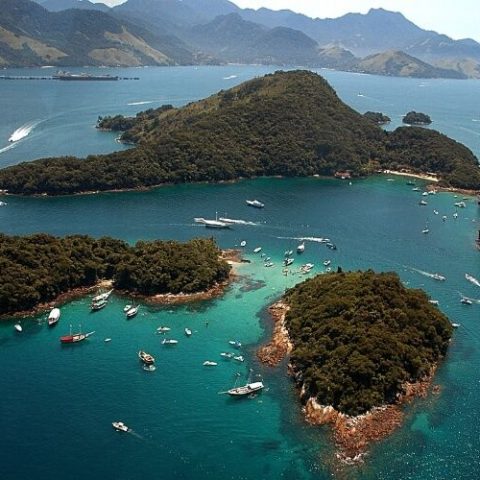
The Galapagos Islands, unique at every turn
Remote archipelago offers exceptional nature observation.
By Eva Stelzer
The Galapagos Islands are one of the most incredible wildlife-watching destinations in the world. Besides the sheer spectacle of the place, this remote archipelago is a land of cactus forests, stark lava formations, lush green highlands, turquoise bays and quintessential tropical beaches, and unique and abundant wildlife at every turn. As a bonus, the location of this archipelago at the earth’s equator makes it a perfect year-round travel destination.
The weather is relatively constant for 12 months of the year and there is always – as one would expect – 12 hours of daytime and 12 hours of nighttime. One of my favourite parts of travelling to the Galapagos Islands is clear illuminated night skies unobstructed by the hue of man made lights.
Darwin himself marvelled at the amazing animals found on the Galapagos Islands. Large and small, the islands are filled with unique species that delight the eye and capture the imagination. With that in mind, here are our 5 must-see Galapagos animals.
Blue-footed Booby
 A beautiful bird with a funny name, the blue-footed boobies are most easily spotted by the signature blue flippers. While the Galapagos Islands aren’t the birds’ exclusive home, it is the breeding ground for about half of the species’ population. Their courtship rituals are a highlight for anyone who sees them. With bowing, wing-spreading and some more clownish behaviour, it’s a sight to behold.
A beautiful bird with a funny name, the blue-footed boobies are most easily spotted by the signature blue flippers. While the Galapagos Islands aren’t the birds’ exclusive home, it is the breeding ground for about half of the species’ population. Their courtship rituals are a highlight for anyone who sees them. With bowing, wing-spreading and some more clownish behaviour, it’s a sight to behold.
Galapagos Tortoise
 These magnificent creatures are so iconic that the island was named after them. (“Galapago” means “tortoise” in Spanish.) In addition to being some of the largest tortoises in the world, they also have remarkably long lifespans, often living for over 170 years. It is believed that the Galapagos tortoises made their way to the island 2-3 million years ago from mainland South America. Now the species is endangered and efforts are underway to save these amazing animals.
These magnificent creatures are so iconic that the island was named after them. (“Galapago” means “tortoise” in Spanish.) In addition to being some of the largest tortoises in the world, they also have remarkably long lifespans, often living for over 170 years. It is believed that the Galapagos tortoises made their way to the island 2-3 million years ago from mainland South America. Now the species is endangered and efforts are underway to save these amazing animals.
Marine Iguana
The only seagoing lizard in the world, this species of iguana lives primarily off of seaweed. They have evolved a short, blunt nose for harvesting algae off of rocks and a long, flattened tail that will help propel them through the water. Their black skin helps them blend in with the islands’ lava rock (subspecies on other islands come in different colours), but during mating season the males turn red or green.
Magnificent Frigatebird
 This species of bird is unmistakable, at least when spotting the male of the species. Known for its giant, red throat pouch, the male magnificent frigatebird certainly lives up to its name. When trying to impress the female, the male’s throat pouch will puff up to jaw-dropping sizes.
This species of bird is unmistakable, at least when spotting the male of the species. Known for its giant, red throat pouch, the male magnificent frigatebird certainly lives up to its name. When trying to impress the female, the male’s throat pouch will puff up to jaw-dropping sizes.
Galapagos Fur Seal
 While the Galapagos Islands might not be home to many mammals, the Galapagos fur seal is an exception. Strictly speaking, the Galapagos fur seals aren’t true fur seals, but are actually a species of fur sea lion. These cuddly-looking creatures spend most of its time out of the water, which makes for excellent sightings. And their calls are ubiquitous all over the island.
While the Galapagos Islands might not be home to many mammals, the Galapagos fur seal is an exception. Strictly speaking, the Galapagos fur seals aren’t true fur seals, but are actually a species of fur sea lion. These cuddly-looking creatures spend most of its time out of the water, which makes for excellent sightings. And their calls are ubiquitous all over the island.
Of course these five are only scratching the surface of wildlife on the Galapagos Islands. Your best bet to experience it is to see it first hand.
How to get to the Galapagos Islands?
The nearest direct is a 2-hour trip from Guayaquil to Baltra Island, Ecuador. I usually recommend that travellers fly from their gateway city to Quito with an overnight stay. From Quito there is a wonderful opportunity to go north to the Andes Mountain range for a few nights before returning for a flight to the Galapagos Islands.
Because of the long distances involved between islands, the most practical way to explore the Galapagos is by live-aboard boats, which travel between islands and make different daily stops. Another option that has gained recent popularity is to stay at a Safari Eco Camp for 5 nights and take daily boat trips to the some of the islands.
Images: courtesy of Eva Stelzer.
To benefit from concierge service and plan a tailor made travel experience just for you call Eva at 514 485-2050 or email her at info@eviactive.com. We specialize in all parts of the world including the Galapagos Islands.
Eva Stelzer is the owner and founder of Evia, a bespoke travel service. A former academic, she has spent many years delivering experiential journeys and travel writing. Learn more at eviactive.com
This article was first published in Westmount magazine on December 23, 2015. Contact info@eviactive.com to learn more about Galapagos Islands Travel.
Check out the original article here. http://www.westmountmag.ca/galapagos/






